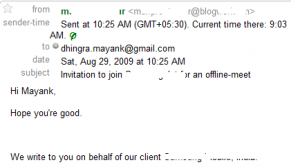Yesterday evening while trying to explain some best practices for writing emails to my younger brother I tried to make my point clear by showing him some examples and asking him to identify the differences. Given the amount of badly designed/structured emails doing rounds it wasn’t hard to find an example of badly designed email from my inbox.
Here are two emails that I picked up for him, both are regarding bloggers meet.

and

Instead of pin-pointing the differences I asked him spot them and it didn’t take him a second to say
“The second email is addressed to you while the first one is SPAM”
Though I wasn’t expecting him to flag the first one as spam but I guess that’s how it would appear to anyone who doesn’t know the context beforehand.
Trying to figure out what was really bad about the first email isn’t rocket science. It’s essentially two very simple things

1) ‘To’ Field: I try to find some clues like who all was the mail addressed to etc, from the ‘To’ field (some people put their entire list in to field btw). As you can see here the email’s ‘from and to’ fields are same. Thankfully email clients don’t work like packet sniffers else this mail would have reach spam folder directly, no questions asked.
Perhaps like we used to think during our college day the sender thought it’s mandatory to have an address in ‘To’ field and therefor it’s their name in the ‘To’ field while the addresses email id’s are shoved in the ‘BCC’ field.
2) ‘Greeting’: It’s basic courtesy (common sense?) to greet someone by their name (unless you are not sure about their name) when sending email and it’s even more important when you are sending mail to a blogger on behalf of a client. The last thing the recipient should think is if it’s a bulk email or worse spam.
Given the fact that recepients of such emails wouldn’t be numerous I don’t think it would have bee a tough job.
5 Tips for Writing Better Emails:
1) Don’t send bulk emails. And if you have to then don’t make it apparent that it’s a bulk email by addressing it like ‘Hi Bloggers’ or ‘Hi Guys’ .
2) Write personal emails:
Emails starting with just ‘Hi’, start on a fishy ground(unless you know the recipient)
 Though the ‘To’ field here has your name unlike in example 1 above since it starts with just ‘Hi’, you can’t assume that this email is just being sent to you.
Though the ‘To’ field here has your name unlike in example 1 above since it starts with just ‘Hi’, you can’t assume that this email is just being sent to you.
3) Avoid generic statements:
‘Your blog makes for very interesting reading’. That’s the kind of lines spammers use these days. Avoid them and insted writing something that seems more genuine and believable.
4) Be relevant/targeted:

Now that’s seriously lame. Thankfully they didn’t add neighbours and relatives to the list.
5) Have an opt-out link: If for whatever reason you plan to send emails to people regularly without asking them before hand at least have a link for them to opt-out from your emailing list.
As with other things finding bad examples is quite easy but finding good examples isn’t. Here’s an example of what could be called a better designed/structured email sent for the first time (to some email list I suppose)

second half
 You might want to checkout this awesome email checklist by Seth Godin and writing more effective emails by Chris Brogan for more on better/effective emails.
You might want to checkout this awesome email checklist by Seth Godin and writing more effective emails by Chris Brogan for more on better/effective emails.
Got some tips to share about writing better emails?



 Though the ‘To’ field here has your name unlike in example 1 above since it starts with just ‘Hi’, you can’t assume that this email is just being sent to you.
Though the ‘To’ field here has your name unlike in example 1 above since it starts with just ‘Hi’, you can’t assume that this email is just being sent to you.

 You might want to checkout this awesome
You might want to checkout this awesome